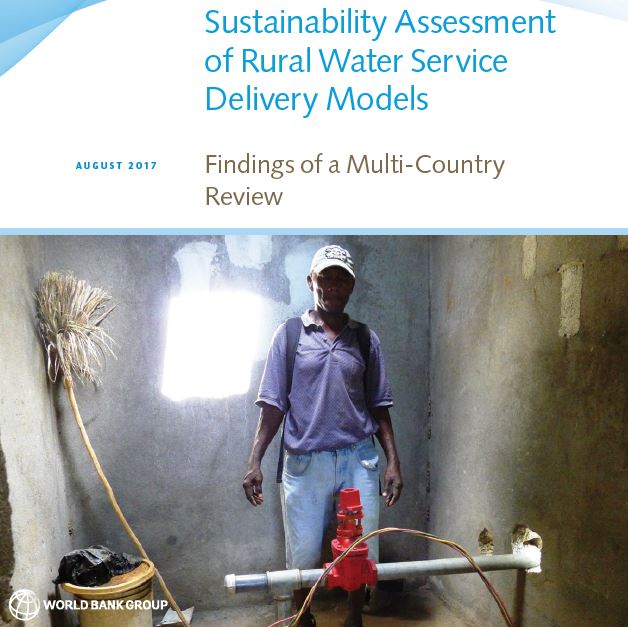Sustainability Assessment of Rural Water Service Delivery Models Findings of a Multi-Country Review
Rationale to Examine the Conditions for Sustainable Rural Water Services The recently issued baseline for the Sustainable Development Goals (SDGs) states that 844 million people in 2015 remain without access to basic water services, and an estimated 2.1 billion without access to safely managed drinking water services, the large majority of those living in rural areas (WHO and UNICEF 2017). Failure by governments and development partners to ensure sustained access to basic water supplies in rural areas is, to a large extent, the result of inadequate investment to deliver infrastructure where needed. It is also the result of a failure to ensure that infrastructure, once in place, continues to effectively provide the expected services over time. Impressive gains from the Millennium Development Goal (MDG) era remain fragile and at risk, with various empirical studies indicating that 30 percent to 40 percent of rural water infrastructure is not functioning or functions below expected service levels (RWSN 2010). With the adoption of the Sustainable Development Goals (SDGs), governments have committed to ensure universal access to water, to close the urban-rural and equity gap, and to deliver higher levels of services in terms of quality, accessibility, and reliability. This implies that a shift in policies and resource allocation is increasingly urgent, going beyond infrastructure delivery and addressing the longer term sustainable management and financing of rural water services. Such a shift needs to respond to well-known capacity gaps for rural water service delivery, which are often exacerbated by decentralization processes (Bakalian et al. 2009; Van Ginneken et al. 2011). The SDGs thus pose a triple challenge: to reach unserved population groups, to improve service levels, and to sustain existing and future services. The issue of the sustainability of rural service provision is not new, and has received widespread attention since the international decade on water and sanitation (1981–90). Initially, the focus to address scheme failure was at the level of the community, particularly during the implementation phase of new schemes. The Demand-Responsive Approach (DRA) was elaborated in the 1990s to ensure that interventions respond better to community needs. However, DRA proved insufficient to address the requirements for support mechanisms to rural populations beyond project implementation (World Bank 2012). Since the 2000s, more emphasis has been placed on post construction support to rural service providers, professionalization, and diversification of service delivery models, including various forms of private sector involvement (Smits and Lockwood 2011). With increasing demand for higher service levels, a service delivery approach is now emerging. This approach recognizes the importance of wider systems of governance and the enabling environment, political economy aspects, life cycle costs, and the role of local institutions (Whaley and Cleaver 2017). In this context, it has become essential to better understand the factors of sustainability for rural water services. Aim, Scope and Limitation of the Assessment This assessment uses a multi-country case study approach to identify good practices and challenges toward building sector capacity and strengthening sustainable service delivery models for rural areas. The overall aim is to contribute to the global knowledge base on what countries are doing to improve the conditions that are likely to have a bearing on the longterm sustainability of rural water services. The case studies also serve to provide policy guidance and practical recommendations to country teams and governments on how to improve the sustainability of their service delivery approach. This assessment does not explicitly focus on the planning, design, and implementation phase of developing water supply facilities, which is equally critical especially for predicting short-term functionality rates. Rather, it analyzes the ongoing service delivery approach for rural water. The scope of the study did not allow for primary data collection at the level of water schemes within the 16 countries. A parallel study was first commissioned by the World Bank to better define sustainability metrics, in order to inform further research (World Bank, forthcoming). In summary, recognizing the limitations of the DRA, the emergence of various management models, the identified need for ongoing support to rural service providers, and the critical role of enabling institutions and policies beyond the community-level, the added value of this assessment lies in: • The development of a comprehensive analytical framework that can be used to analyze and operationalize a more sustainable service delivery approach for rural water supply • The rich set of cases and good practices from the 16 countries informing the global body of “knowledge in implementation” • The formulation of recommendations and policy directions to improve the sustainability of services depending on sector development stage and the rural service delivery context
